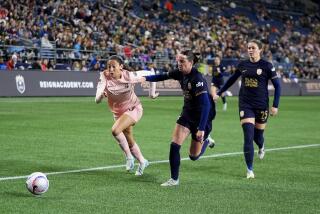Jane Fonda, Eat Your Heart Out
Like many homemakers, Nancy Strick has a daily routine. On weekdays, she gets up at 7 a.m. with her two children, eats breakfast and watches as they head off for school. Then she takes care of household chores.
It’s like clockwork, except for Fridays. On Fridays, after seeing her children off, Strick, 42, picks up buddies Sally Yeatsman and Pat Klowden, and they meet up with a group of 30- and 40-something Westside women.
But these women are not dressed for a ladies lunch. Instead they wear soccer cleats and pads for a good-natured game of pickup soccer in Clover Park field in Santa Monica.
Goals are placed at opposite ends of the playing field and teams are formed: one wearing dark-colored shirts and the other donning light-colored shirts.
On a recent Friday, two middle-aged men--neither of whom looked as though he had exercised recently--watched in amusement as the women huffed and puffed up and down the field.
After nearly a year of these games, the women say they are used to attracting the snickers of curious joggers and passersby.
“We get a lot of funny looks,” said Strick, who organizes the pickup games. “People are surprised we do it. But it’s fun, and it’s a heck of a lot better than aerobics tapes.”
Strick, who also does consulting work in parent education and coaches youngsters for the American Youth Soccer Organization, organized the games after working at an AYSO-sponsored clinic for women who wanted to act as assistants for their coaching husbands. Many women at the clinic were excited by the idea of playing but had never actually taken to the field and were unfamiliar with the sport’s rules.
So Strick decided the best way for these wives and moms to learn the game was to play.
She sought out additional players at such places as grocery stores and PTA meetings, and had no problem gathering enough women to play. Although a majority who expressed interest were mothers, motherhood is not a prerequisite.
“We take any able-bodied person that we see that has two legs,” she said.
Off the field, the players come from all walks of life. They are professors, businesswomen, social workers, teachers, doctors and full-time moms.
The original recruits now recruit their friends. The number of participants varies from week to week, Strick said, with the turnout ranging anywhere from five to more than 20. The games have become an important aspect of the women’s weekly routines, Strick said, and oftentimes family events and work appointments are scheduled around Friday mornings.
“There are people who plan vacations around this date,” said Strick, adding that the game time is not negotiable. “All our friends know that we play on Friday mornings.”
While on the field recently, the neophyte athletes--some dressed in oversized T-shirts and bright neon baseball hats--often did more walking than running, but the level of competition was still intense.
“Come on, get here . . . somebody get here,” shouted goalie Trudi Ferguson, urging her teammates to help defend the goal. “You guys keep your feet down. . . . C’mon, looking good.”
Pam Hanson, another weekly participant, said she was pleasantly surprised by the level of competition. “I thought I’d have (to play with) a bunch of PTA moms who didn’t want to get wet,” said Hanson, who would only describe her age as 30-something. “But these guys are competitive. They will slide right through a puddle.”
The group gets by without a referee.
“We’ve never had an argument we couldn’t solve,” Strick said.
For the most part, the women play by the same rules as regulation soccer, bending them only to fit certain needs. For instance, if there are not enough players to make up two complete teams, the goalies are not allowed to use their hands on defense.
As for halftime, there isn’t one. Breaks are simply taken whenever a player wants a timeout. And when the ball rolls out of bounds, an unwritten rule requires the person with the most energy to retrieve it.
The primary goal is to have fun, Strick said. And they seem to have plenty of that. When a team scores a goal, women on both sides raise up congratulatory high fives for the scorer. But at the end of each contest, don’t ask about a final score or who scored because the women probably won’t remember.
For many, the games are an indication of just how much things have changed during their lives.
Ferguson explained that many of the women are simply making up for an experience that was considered improper when they were younger.
“These are competitive women,” she said. “And it wasn’t OK to be competitive when we were 16, so now we’re being competitive at 40.”
More to Read
Go beyond the scoreboard
Get the latest on L.A.'s teams in the daily Sports Report newsletter.
You may occasionally receive promotional content from the Los Angeles Times.










